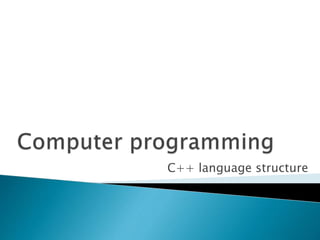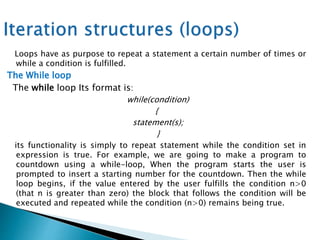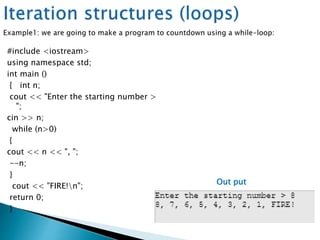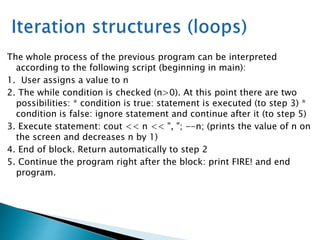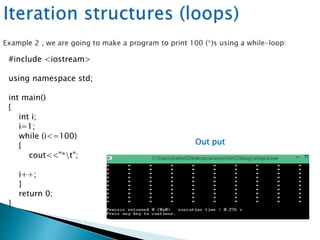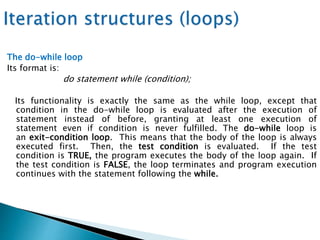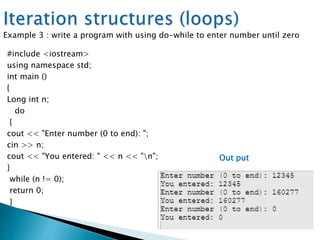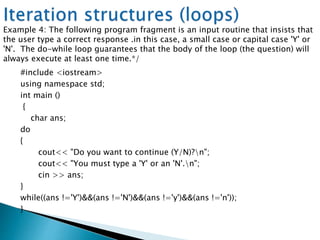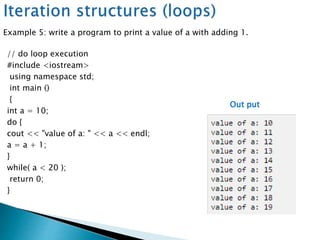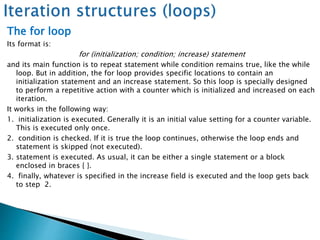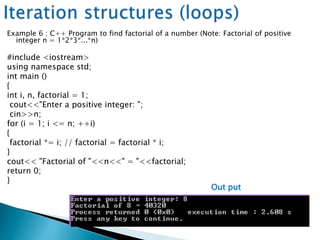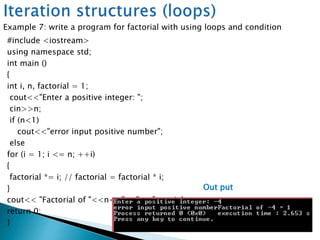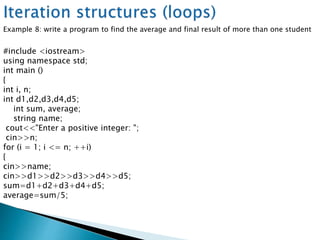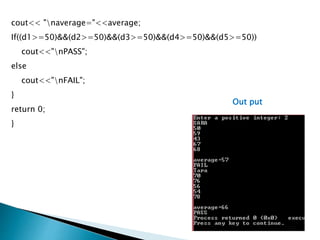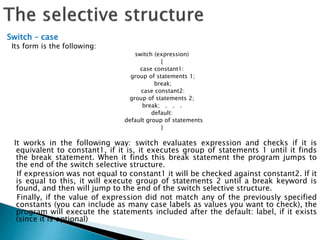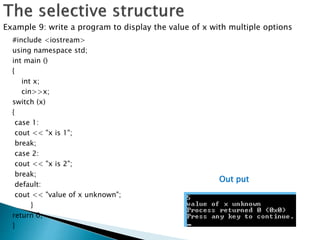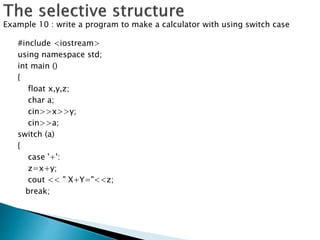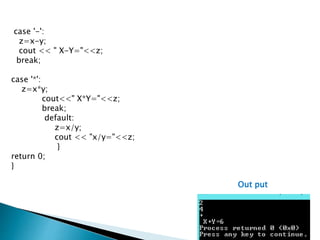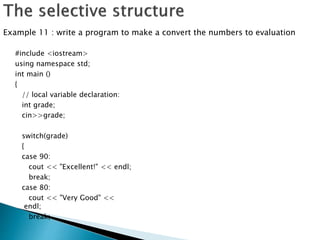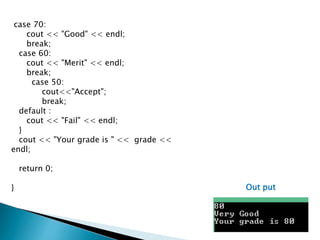C++ loop
- 2. Loops have as purpose to repeat a statement a certain number of times or while a condition is fulfilled. The While loop The while loop Its format is: while(condition) { statement(s); } its functionality is simply to repeat statement while the condition set in expression is true. For example, we are going to make a program to countdown using a while-loop, When the program starts the user is prompted to insert a starting number for the countdown. Then the while loop begins, if the value entered by the user fulfills the condition n>0 (that n is greater than zero) the block that follows the condition will be executed and repeated while the condition (n>0) remains being true.
- 3. #include <iostream> using namespace std; int main () { int n; cout << "Enter the starting number > "; cin >> n; while (n>0) { cout << n << ", "; --n; } cout << "FIRE!n"; return 0; } Out put
- 4. The whole process of the previous program can be interpreted according to the following script (beginning in main): 1. User assigns a value to n 2. The while condition is checked (n>0). At this point there are two possibilities: * condition is true: statement is executed (to step 3) * condition is false: ignore statement and continue after it (to step 5) 3. Execute statement: cout << n << ", "; --n; (prints the value of n on the screen and decreases n by 1) 4. End of block. Return automatically to step 2 5. Continue the program right after the block: print FIRE! and end program.
- 5. #include <iostream> using namespace std; int main() { int i; i=1; while (i<=100) { cout<<"*t"; i++; } return 0; } Out put
- 6. The do-while loop Its format is: do statement while (condition); Its functionality is exactly the same as the while loop, except that condition in the do-while loop is evaluated after the execution of statement instead of before, granting at least one execution of statement even if condition is never fulfilled. The do-while loop is an exit-condition loop. This means that the body of the loop is always executed first. Then, the test condition is evaluated. If the test condition is TRUE, the program executes the body of the loop again. If the test condition is FALSE, the loop terminates and program execution continues with the statement following the while.
- 7. #include <iostream> using namespace std; int main () { Long int n; do { cout << "Enter number (0 to end): "; cin >> n; cout << "You entered: " << n << "n"; } while (n != 0); return 0; } Example 3 : write a program with using do-while to enter number until zero Out put
- 8. #include <iostream> using namespace std; int main () { char ans; do { cout<< "Do you want to continue (Y/N)?n"; cout<< "You must type a 'Y' or an 'N'.n"; cin >> ans; } while((ans !='Y')&&(ans !='N')&&(ans !='y')&&(ans !='n')); } Example 4: The following program fragment is an input routine that insists that the user type a correct response .in this case, a small case or capital case 'Y' or 'N'. The do-while loop guarantees that the body of the loop (the question) will always execute at least one time.*/
- 9. // do loop execution #include <iostream> using namespace std; int main () { int a = 10; do { cout << "value of a: " << a << endl; a = a + 1; } while( a < 20 ); return 0; } Out put Example 5: write a program to print a value of a with adding 1.
- 10. The for loop Its format is: for (initialization; condition; increase) statement and its main function is to repeat statement while condition remains true, like the while loop. But in addition, the for loop provides specific locations to contain an initialization statement and an increase statement. So this loop is specially designed to perform a repetitive action with a counter which is initialized and increased on each iteration. It works in the following way: 1. initialization is executed. Generally it is an initial value setting for a counter variable. This is executed only once. 2. condition is checked. If it is true the loop continues, otherwise the loop ends and statement is skipped (not executed). 3. statement is executed. As usual, it can be either a single statement or a block enclosed in braces { }. 4. finally, whatever is specified in the increase field is executed and the loop gets back to step 2.
- 11. Example 6 : C++ Program to find factorial of a number (Note: Factorial of positive integer n = 1*2*3*...*n) #include <iostream> using namespace std; int main () { int i, n, factorial = 1; cout<<"Enter a positive integer: "; cin>>n; for (i = 1; i <= n; ++i) { factorial *= i; // factorial = factorial * i; } cout<< "Factorial of "<<n<<" = "<<factorial; return 0; } Out put
- 12. #include <iostream> using namespace std; int main () { int i, n, factorial = 1; cout<<"Enter a positive integer: "; cin>>n; if (n<1) cout<<"error input positive number"; else for (i = 1; i <= n; ++i) { factorial *= i; // factorial = factorial * i; } cout<< "Factorial of "<<n<<" = "<<factorial; return 0; } Example 7: write a program for factorial with using loops and condition Out put
- 13. #include <iostream> using namespace std; int main () { int i, n; int d1,d2,d3,d4,d5; int sum, average; string name; cout<<"Enter a positive integer: "; cin>>n; for (i = 1; i <= n; ++i) { cin>>name; cin>>d1>>d2>>d3>>d4>>d5; sum=d1+d2+d3+d4+d5; average=sum/5; Example 8: write a program to find the average and final result of more than one student
- 15. Switch – case Its form is the following: switch (expression) { case constant1: group of statements 1; break; case constant2: group of statements 2; break; . . . default: default group of statements } It works in the following way: switch evaluates expression and checks if it is equivalent to constant1, if it is, it executes group of statements 1 until it finds the break statement. When it finds this break statement the program jumps to the end of the switch selective structure. If expression was not equal to constant1 it will be checked against constant2. If it is equal to this, it will execute group of statements 2 until a break keyword is found, and then will jump to the end of the switch selective structure. Finally, if the value of expression did not match any of the previously specified constants (you can include as many case labels as values you want to check), the program will execute the statements included after the default: label, if it exists (since it is optional)
- 16. #include <iostream> using namespace std; int main () { int x; cin>>x; switch (x) { case 1: cout << "x is 1"; break; case 2: cout << "x is 2"; break; default: cout << "value of x unknown"; } return 0; } Example 9: write a program to display the value of x with multiple options Out put
- 17. #include <iostream> using namespace std; int main () { float x,y,z; char a; cin>>x>>y; cin>>a; switch (a) { case '+': z=x+y; cout << " X+Y="<<z; break; Example 10 : write a program to make a calculator with using switch case
- 18. case '-': z=x-y; cout << " X-Y="<<z; break; case '*': z=x*y; cout<<" X*Y="<<z; break; default: z=x/y; cout << "x/y="<<z; } return 0; } Out put
- 19. #include <iostream> using namespace std; int main () { // local variable declaration: int grade; cin>>grade; switch(grade) { case 90: cout << "Excellent!" << endl; break; case 80: cout << "Very Good" << endl; break; Example 11 : write a program to make a convert the numbers to evaluation
- 20. case 70: cout << "Good" << endl; break; case 60: cout << "Merit" << endl; break; case 50: cout<<"Accept"; break; default : cout << "Fail" << endl; } cout << "Your grade is " << grade << endl; return 0; } Out put

